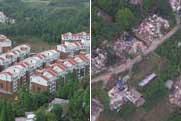China
Chang´e I breaks Chinese space record
Source: CRI | 10-31-2007 09:57
Special Report: Chang'e I -Journey to the MoonChina's first lunar probe Chang'e I has broken the country's space explore record by travelling farther from the planet than any other domestic orbiter after it roamed to the apogee of its third orbit Tuesday afternoon.
The satellite reached a point about 120,000 kilometers away from the Earth at 5:40pm Tuesday, besting its predecessor Tance-1 which flew 80,000 kilometers from Earth in December, 2003, Xinhua news agency reported.
The orbiter, named after the Chinese goddess who, according to legend, flew to the moon, opened its ultraviolet image sensors about 7am Tuesday and began work to collect information on the Earth, the report said.
The images will be transmitted back to the Earth when it enters lunar orbit later this week, the report said.
The orbiter transferred to a 48-hour orbit at 6:01pm Monday, another crucial step forward in its 1,580,000-km journey to the moon.
It will stay in the orbit until tomorrow before entering the Earth-moon transfer orbit, a critical point that may determine whether the satellite can fly to the moon successfully or not, according to the Beijing Aerospace Control Center.
The probe completed its second orbital transfer Friday, which made it move on a 24-hour orbit with an apogee of 70,000 km, up from the former 50,000 km.
Chang'e I blasted off on a Long March3A carrier rocket at 6:05pm last Wednesday from the Xichang Satellite Launch Center in the southwestern province of Sichuan, marking the first step of China's three-stage moon mission, which will lead to a moon landing and launch of a moon rover around 2012.
The 2,300-kg satellite is expected to arrive in the moon's orbit next Monday with eight probing facilities, including a stereo camera and interferometer, an imager and gamma/x-ray spectrometer, a laser altimeter, a microwave detector, a high energy solar particle detector and a low energy ion detector, Xinhua said.
It will fulfill four scientific objectives, including a three-dimensional survey of the moon's surface, analysis of the abundance and distribution of elements on lunar surface, an investigation of the characteristics of lunar regolith and the powdery soil layer on the surface, and an exploration of the circumstance between the earth and the moon.
The satellite will relay the first picture of the moon in late November and will then continue scientific exploration of the moon for a year.
In the third phase of the country's moon mission, another rover will land on the moon and return to Earth with lunar soil and stone samples in about 2017.
Editor:Yang Jie



